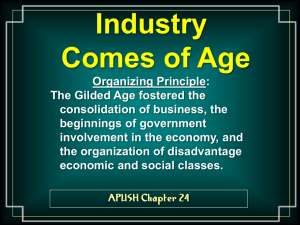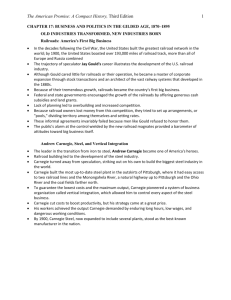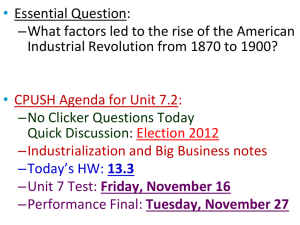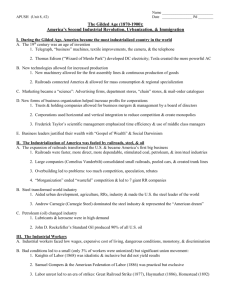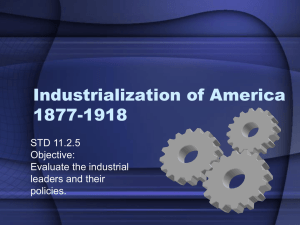APUS Unit 6 Ch.24 Industry Comes of Age PPT Part1
advertisement
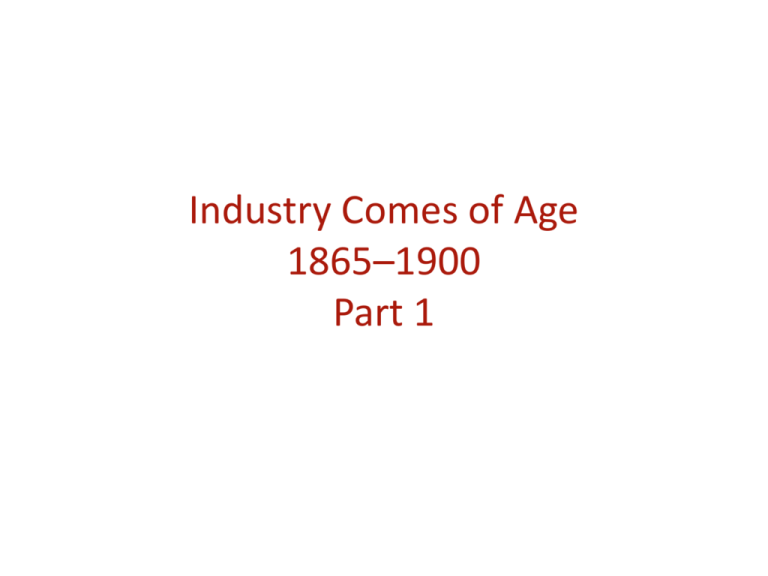
Industry Comes of Age 1865–1900 Part 1 Key Concept 6.1: Technological advances, large-scale production methods, and the opening of new markets encouraged the rise of industrial capitalism in the United States. I. Large-scale industrial production — accompanied by massive technological change, expanding international communication networks, and pro-growth government policies — generated rapid economic development and business consolidation. • A) Following the Civil War, government subsidies for transportation and communication systems helped open new markets in North America. • B) Businesses made use of technological innovations, greater access to natural resources, redesigned financial and management structures, advances in marketing, and a growing labor force to dramatically increase the production of goods. • C) As the price of many goods decreased, workers’ real wages increased, providing new access to a variety of goods and services; many Americans’ standards of living improved, while the gap between rich and poor grew. • D) Many business leaders sought increased profits by consolidating corporations into large trusts and holding companies, which further concentrated wealth. • E) Businesses and foreign policymakers increasingly looked outside U.S. borders in an effort to gain greater influence and control over markets and natural resources in the Pacific Rim, Asia, and Latin America. II. A variety of perspectives on the economy and labor developed during a time of financial panics and downturns. • A) Some argued that laissez-faire policies and competition promoted economic growth in the long run, and they opposed government intervention during economic downturns. • B) The industrial workforce expanded and became more diverse through internal and international migration; child labor also increased. • C) Labor and management battled over wages and working conditions, with workers organizing local and national unions and/ or directly confronting business leaders. • D) Despite the industrialization of some segments of the Southern economy — a change promoted by Southern leaders who called for a “New South” — agriculture based on sharecropping and tenant farming continued to be the primary economic activity in the South. III. New systems of production and transportation enabled consolidation within agriculture, which, along with periods of instability, spurred a variety of responses from farmers. • A) Improvements in mechanization helped agricultural production increase substantially and contributed to declines in food prices. • B) Many farmers responded to the increasing consolidation in agricultural markets and their dependence on the evolving railroad system by creating local and regional cooperative organizations. • C) Economic instability inspired agrarian activists to create the People’s (Populist) • Party, which called for a stronger governmental role in regulating the American economic system. The Bosses of the Senate Joseph Kepler in Puck 1889 https://www.senate.gov/artandhistory/art/artifact/Ga_Cartoon/Ga_cartoon_38_00392.htm Gilded Age Economics • Rapid growth of industry – Railroads link the entire country into a national economic system – Corporations promote industrial growthmonopolies formed – Factory system – Mass production of interchangeable parts These trends began before the Civil War. They increased/grew enormously during the Gilded Age Key Industries of the Gilded Age • • • • • • Railroads Oil Steel Banking Coal Farm equipment Factors that Facilitated Industrialization • • • • Techniques of mass production Natural resources of the U.S. Labor supply; immigration Inventions (440,000 new patents 1860-1890) – – – – – – Typewriter (1867) Phone (1876, Alexander Graham Bell) Cash register (1879) (first practical) Light bulb (1879, Thomas Edison) Air Brake for railroads (1878, George Westinghouse) Transformer (1885, Westinghouse; made possible the lighting of cities, streetcars, appliances, etc.) Consumer Economy and a Consumer Culture • Increased output of factories and the invention of new products prompted consumer marketing • R.H. Macy (NY) • Marshall Field (Chicago) • Woolworth’s Five and Ten • Sears Roebuck (mail order) • Montgomery Ward (mail order) • Kellogg • Post Changing Socio-economic Classes • Industrial capitalists • Growing middle class • Wage-earning class – By 1900 2/3rds of all working Americans worked for wages – Real wages rose, but most wage earners could not support a family well on one income • (status of various groups- African Americans, Asian Americans, women, immigrants- was lower socio-economically compared to whites) • Growth of a millionaire class – By 1900, 10% of the American people controlled 90% of the wealth Government Regulation • 1776 Adam Smith, The Wealth of Nationsargued that business should be regulated by the “invisible hand,” not by government (businesses will be motivated to help society because it is in their own best interest) • Laissez-faire- “hands off”- government should not regulate business • Industrialization led to knew debates over the issue of government regulation Railroads • 1865- 35,000 miles of rail • 1900- 192,556 miles • More than all of Europe combined • Government subsidized the building of railroads (loans and land grants) -railroad construction was costly and risky -gov’t received preferential rates for postal service and military transportation Transcontinental Railroad • • • • • • • Union Pacific (from the east w/ Irish labor) Central Pacific (from the west w/ Chinese labor) Completed 1869 (Promontory Point, Utah) Great engineering feat Tied West Coast more closely to the Union Facilitated trade w/ Asia Paved the way for the growth of the West • Consolidation of railroads – Creation of regional monopolies • (interlocking directorates of bankers such as Morgan eliminated competition) – Pools- an agreement to divide the business in a given area and share the profits – Rebates- kickbacks to powerful shippers for steady and assured traffic (such as Standard Oil) • Cornelius Vanderbilt – Improved NY City railroad – Offered service at a lower rate – Replaced iron tracks with steel – Made $100 million (richest man in America at the time; worth more than the U.S. Treasury had) – “Law! What do I care about the law? Ain’t I got the power?” Cornelius Vanderbilt Mansion Biltmore Estate, Asheville, NC Built by George Vanderbilt (grandson). Opened 1895 Railroads Transformed American Life • the nation became more united in a physical sense • Creation of a huge domestic market for American goods, spurring domestic and foreign investors; • spurred, more than any other factor, industrialization of the post-Civil War years • rails generated the largest single source of orders for the new steel industry • led the movement to the city of the last decades of the century • railroad companies stimulated immigration through their selling of land grants • environmental and ecological impact • standard time was instituted in 1883 as a result of railroad schedules • more than any other single factor, railroads contributed to the rise of a millionaire aristocracy. Figure 24-1 p513 Map 24-1 p514 p517 p518 Grange • Farmers impacted by high freight rates • Patrons of Husbandry • Agrarian group that called for state regulation of the railroad monopoly • 1870s- some states passed laws regulating railroad rates Wabash Case • Wabash, St. Louis & Pacific Railway Co. v. Illinois • 1886 • Supreme Court declared that individual states had no power to regulate interstate commerce • An important result of Wabash was that the Court clearly established the exclusive power of Congress to regulate interstate commerce. (See Gibbons v. Ogden.) p521 The Supremacy of Steel • Bessemer process – cold air blown on red-hot steel caused the metal to become white hot and burn off impurities Carnegie and Other Sultans of Steel p522 U.S. Steel U.S. Steel • Morgan bought out Carnegie’s steel interests for $400 million • U.S. Steel launched 1901 • America’s first billion-dollar corporation John D. Rockefeller Oil John D. Rockefeller • 1859- first American oil well drilled in PA • 1870 Rockefeller founded Standard Oil Company • Used railroad rebates and price cutting to force rivals out of business • Horizontal integration used to reduce competition (competitors were brought under the control of the Standard Oil Trust) • By 1881 Rockefeller had 90% of the oil refining business • Rockefeller worth $900 million p523 Vertical integration-combining into one organization all phases of manufacturing from mining to marketing -pioneered by Carnegie Benefits- improved efficiency, better control of quality, and elimination of middleman fees Horizontal integration-allying with competitors to monopolize a given market -pioneered by Rockefeller Trust-a combination of firms or corporations formed by a legal agreement -used by Rockefeller to eliminate competition -stockholders in small companies would assign their stock to the board of directors of Standard Oil Company. Standard Oil then consolidated operations -Standard Oil controlled most of the world’s oil production Interlocking directorates -designed by Morgan to consolidate rival enterprises and eliminate competition -officers of his banking syndicate were placed on the various boards of directors of rival enterprises. Social Darwinism • “Survival of the fittest”- coined by Herbert Spencer • Carnegie was influenced by Spencer • Spencer applied Charles Darwin’s concept of natural selection to society • Supported the idea of competition in a laissezfaire capitalist society


